In Flanders, shortly after the arrival in late Spring of 1917, the military instruction of the Portuguese army continued. Every day, the soldiers went through six hours of intensive training, including shooting practice in the few existing shooting ranges, gymnastics, fencing, exercises with machine guns and grenades, as well as the famous maneuvers with gas masks.
One breathed through a tube, with the nostrils pinched. The glass became fogged. Men ceased being men, as they turned into silhouettes crammed in a closed shelter behind a black drape.
The Portuguese sector was located in the valley of the Lys river, from Armentieres to La Bassée, from Merville to Bethune.
The troops were distributed into three different spaces: rear defense zone, battle zone, and advanced zone.
Instructional visits to the battle front soon became part of the routine.
The main official responsible for discipline and for full compliance with all orders was the captain. During night or day, he visited the trenches, reported casualties by telegraph, and sent reports on the progress.
Soldiers went missing from the units.
Fear grew. Stones got confused with human silhouettes, the shadow of a tree with the movement of a man. As minutes passed, the darkness of the night turned bright by the firing of white rockets, lighting up "no man's land".
The captain shouts: "Let there be silence, let there be serenity". The soldiers rise with their pistols, and run toward the front line.
Print this page


Comments